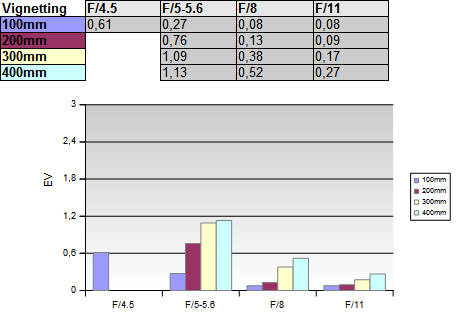|
Canon EF 100-400mm f/4.5-5.6 USM L IS II - Full Format Review / Test Report - Analysis |
|
Lens Reviews -
Canon EOS (Full Format)
|
|
Page 2 of 3

Distortion
The Canon lens produces a slight barrel distortion at 100mm changing to slight-medium pincushion distortions towards longer tele settings. This is decent although it's also nothing out of the ordinary here.
Vignetting
The Canon EF 100-400mm f/4.5-5.6 USM L IS II shows a fairly moderate light falloff on full format DSLRs. The vignetting is very low at 100/200mm but increases to around 1EV (1 f-stop) at 300/400mm. Closing the aperture by one stop improves the issue to an essentially negligible degree.

MTF (resolution & chromatic aberrations)
The primary value proposition is usually image sharpness so can it deliver here? Yes, it can. The image center is generally excellent if not outstanding at max. aperture and down to f/11. The borders and corners are easily very good. The peak performance is reached around 200mm. The weakest spot is, unsurprisingly, the 400mm setting but even so the quality remains impressive for such a lens here.
The centering quality of the tested sample was very good. The field curvature is negligible.
Please note that the MTF results are not directly comparable across the different systems!
Below is a simplified summary of the formal findings. The chart shows line widths per picture height (LW/PH) which can be taken as a measure for sharpness.
If you want to know more about the MTF50 figures you may check out the corresponding Imatest Explanations
Chromatic Aberrations (CAs)
Lateral chromatic aberrations (color shadows at the image borders) reach an average pixel width of 1px at the image borders ... at 100mm. Beyond the CAs decrease to next to nothing which is an outstanding achievement by Canon.

Bokeh
Due to the small max. aperture the out-of-focus blur is somewhat underdeveloped - the lens isn't really meant for portraits. Nevertheless you can achieve a small depth-of-field using a long focal length in conjunction with a fairly close object distance.
In this context, the bokeh quality is good and also slightly better than on the mk I. Out-of-focus highlight discs are decently rendered with just a bit of nervousness in the inner zone and a slightly visible disc halo. The mk II features 9 aperture blades now so a more edgy aperture shape shows up quite "late" (f/11).
 Most lenses produce so-called "cat's eye" highlights (see below) at the image borders/corners and fully open aperture - this is a vignetting effect and it also applies to the Canon EF 100-400mm f/4.5-5.6 USM L IS II. Stopping down improves the shape towards a disc-shape again.
Most lenses produce so-called "cat's eye" highlights (see below) at the image borders/corners and fully open aperture - this is a vignetting effect and it also applies to the Canon EF 100-400mm f/4.5-5.6 USM L IS II. Stopping down improves the shape towards a disc-shape again.
 As far as the general out-of-focus blur is concerned - the background is pretty smooth (left hand sample crop below) whereas the less critical foreground blur (to the right) is somewhat more harsh.
As far as the general out-of-focus blur is concerned - the background is pretty smooth (left hand sample crop below) whereas the less critical foreground blur (to the right) is somewhat more harsh.
 Note: the samples were taken at 400mm here.
Note: the samples were taken at 400mm here.
Bokeh Fringing / Longitudinal Chromatic Aberrations (LoCA)
The so-called bokeh fringing refers to colored halos in the focus transition zone. Hard contrasts can have a purple color tint in the foreground changing to greenish beyond the focus point. This aspect is mostly an issue for ultra-large aperture lenses and the Canon EF 100-400mm f/4.5-5.6 USM L IS II is hardly affected by this even at max. aperture.
|